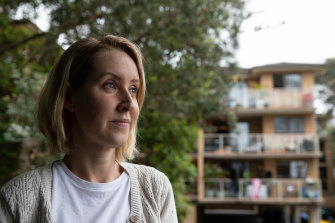Highly stressful Red-hot property market tests banks home loan factories
Lucy McLelland has experienced first-hand the stress of trying to secure a speedy loan approval in Sydney’s fiercely competitive property market.
Needing more space for her family of three, she and her husband bought a house in Allambie Heights in Sydney’s Northern Beaches late last month, upsizing from a Manly apartment.
But to close the deal, they had to move fast. So fast they signed the contract of sale just five days after finding the property, without getting formal approval for a mortgage.

Lucy McLelland has recently bought a house in Allambie Heights, Sydney, to upsize from her Manly apartment.Credit:Janie Barrett
McLelland says that with another buyer also competing for the property, they decided to sign the contract after their mortgage broker got an indicative “sanity check†on their loan application from the lender. The bank, Macquarie, ended up approving the loan application in four days - which McLelland now says was a quick turnaround time.
“I had assumed the process would be quicker, but now I understand what the process involves,†she says.
McLelland, who works in strategy for a software company, describes the experience of buying and arranging finance in a rush as “hideous, highly stressfulâ€. But she is looking forward to moving into a home with a backyard, after working at home in a unit through the COVID-19 pandemic. “We are super excited,†she says.
Her story underlines the pressure on banks to quickly process loan applications in a red-hot market, fuelled by ultra-low interest rates and low stock levels.
For others, however, delays in getting approved for a loan can be a deal-killer.
Amit Sachdeva wanted to buy a family home in Melbourne’s southeastern suburb of Noble Park. The three-bedroom house was within walking distance from his six-year-old’s school and “beautifully builtâ€.
Sachdeva and his wife both work full-time and have an existing mortgage with ANZ after refinancing their CBA mortgage last year to take advantage of better rates and a cashback offer. With a 30 per cent deposit ready to go, Sachdeva assumed the loan application process would be quick.
“I’m an existing customer, they have all my information,†says the 37-year-old father of two. “But I lost the house I really wanted to buy at that time.â€

Amit Sachdeva with one of his children. He lost the home he wanted to buy because of a slow approval process.Credit:Wayne Taylor
Sachdeva had applied for the loan through a mortgage broker and says painful delays meant another buyer snapped up the property before ANZ could guarantee the finance.
Both stories reflect what has become a critical battleground for the country’s big banks: processing mortgages quickly and consistently amid a tsunami of loan applications.
How well banks have managed this flood of loan applications has become a major problem for some, and a big advantage for others.
For ANZ, mortgage processing has been a major weakness. Its latest financial results showed sluggish growth in its home loan book, with chief executive Shayne Elliott admitting the bank was not ready for the mortgage boom caused by low interest rates, high government stimulus and lockdowns that sent savings skyrocketing.
‘The last thing buyers want is for their bank to drag its heels when there’s a deadline looming.’
Sally Tindall, director of research at RateCityA few years ago, ANZ made the decision to rely on manual processing for mortgages coming through broker channels as one way to reduce risk following the banking royal commission that exposed predatory lending.
But now, as the major banks battle to decrease their “time to yes†in order to boost market share in mortgages, ANZ has fallen behind.
With 53 per cent of ANZ’s mortgages coming through the broker channel, ANZ’s retail bank executive Mark Hand took responsibility for the bank’s systems being overwhelmed and vowed to turn things around. “It’s on me,†he said.
‘Perfect storm’However, ANZ is far from alone. Chief executive of wholesale mortgage broker AFG, David Bailey, says that in the last year, some banks’ systems were not prepared for the influx of broker-written loans. Ultra-low interest rates, a buoyant property market and a jump in refinancing spurred on by generous “cash-back†deals have also fanned the flames.
“It was almost a perfect storm,†Bailey says. “With extra low interest rates, people were saying ‘let’s lock that in’.â€
Director of research at RateCity, Sally Tindall, cites official figures showing 1 million home loan applications were settled in the last year, up 30 per cent from the previous year. She says the massive increase has put a major strain on many banks’ outdated legacy systems, when banks were also struggling with staffing challenges due to the COVID-19 pandemic. For many customers, the result was lengthy delays.
“Home loan turnaround times can be critical when buying a property because the last thing buyers want is for their bank to drag its heels when there’s a deadline looming,†Tindall says.
Figures from AFG show the average time taken to approve a loan blew out to a peak of 27 days around the middle of this year, compared with 18 days in 2018.
For banks and their shareholders, meanwhile, there have been winners and losers from the surge in home lending - which is the biggest source of profit for the big four.
EY banking and capital markets leader Tim Dring says that although mortgage lending has almost doubled in the past year, there has been a marked divergence between home loan performance among the major banks. “I think it’s a very important battleground,†he says.
Aside from ANZ’s mortgage processing woes, Westpac’s latest results were also dogged by a poor performance in its flagship home lending business, sparking a dramatic fall in its share price.
After hemorrhaging market share last year, the bank managed to expand its home loan portfolio in line with other major banks in the latest six-month period.
But it came at a price as new customers taking out loans are paying much lower rates than existing clients. Westpac’s net interest margin - which compares funding costs with what it charges for loans - collapsed by 10 basis points to 1.98 per cent in the second half.
Westpac chief executive Peter King says there is a lot of capital being pumped into mortgage lending, and along with low interest rates, this has crunched margins. But the lender appears determined to hold its ground.
“There’s plenty of competition, there’s plenty of capital, and then because we’ve chosen to grow into that lower-yield market then the margin comes down,†King said at its results.

Macquarie Group CEO Shemara Wikramanayake says there are opportunities for the bank to grow its share of the home loan market.
While some banks have struggled, the banks getting the highest marks from investors for their mortgage processing tend to be Macquarie Group and the Commonwealth Bank. Both lending giants put their success down to investments in technology and systems that allow fast turnaround times.
Macquarie said in its latest results that its home loan portfolio had swelled by 14 per cent since March, giving it 3.8 per cent of the Australian market. The bank has gained a reputation for quick turnaround times with brokers, and is targeting lower-risk borrowers such as professionals who have lower loan-to-valuation ratios. Chief executive Shemara Wikramanayake said at the time there was plenty of potential for it to take more share. “We’re still small in a big market, and [there’s] a lot of opportunity to keep growing there,†she said.
CBA will publish its September quarter trading update next week, but the lender has carved out an even more dominant position in home lending throughout COVID-19, with its market share hitting 26 per cent at its latest results.
Given the huge profits available from home loans, banks that struggled to deal with the wave of loan applications are vowing to lift their game.
With fintechs eyeing the market, and more customers doing their banking online, all lenders are frantically trying to simplify their loan processing as they roll out digital mortgages that make greater use of automation to test if borrowers can afford a loan.
‘One thing which is really clear ... given how hot the property market is, being able to get a quick decision to a customer is just super important.’
Rachel Slade, NAB executive in charge of personal bankingNAB’s executive in charge of personal banking, Rachel Slade, says buyers are often under stress in trying to find the right house, so a speedy decision to give them confidence to make an offer is “absolutely criticalâ€.
“One thing which is really clear, particularly over the last year, given how hot the property market is, being able to get a quick decision to a customer is just super important,†says Slade, who notes that October was also a bumper month for loan applications.
Bendigo and Adelaide Bank has managed to carve out a bigger share in mortgages for three years in a row, and its chief executive Marnie Baker also points to moves to simplify approvals, and sell loans through branches, brokers and online. “We’re pretty pleased that we’ve got those ingredients right at the moment,†Baker said this week.
With the property market still running hot as the economy reopens, most banks remain upbeat about loan growth in their all-important mortgage businesses in the months ahead.
How quickly they handle the flows will remain a critical test for these businesses.

0 Response to "Highly stressful Red-hot property market tests banks home loan factories"
Post a Comment